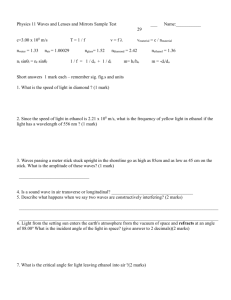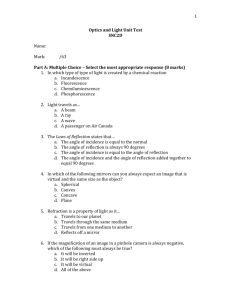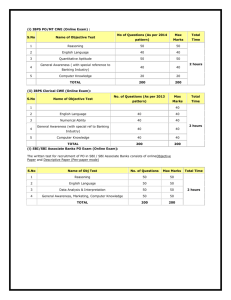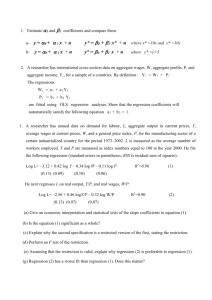Syllabus of Upgraded Secondary School Teachers Exam
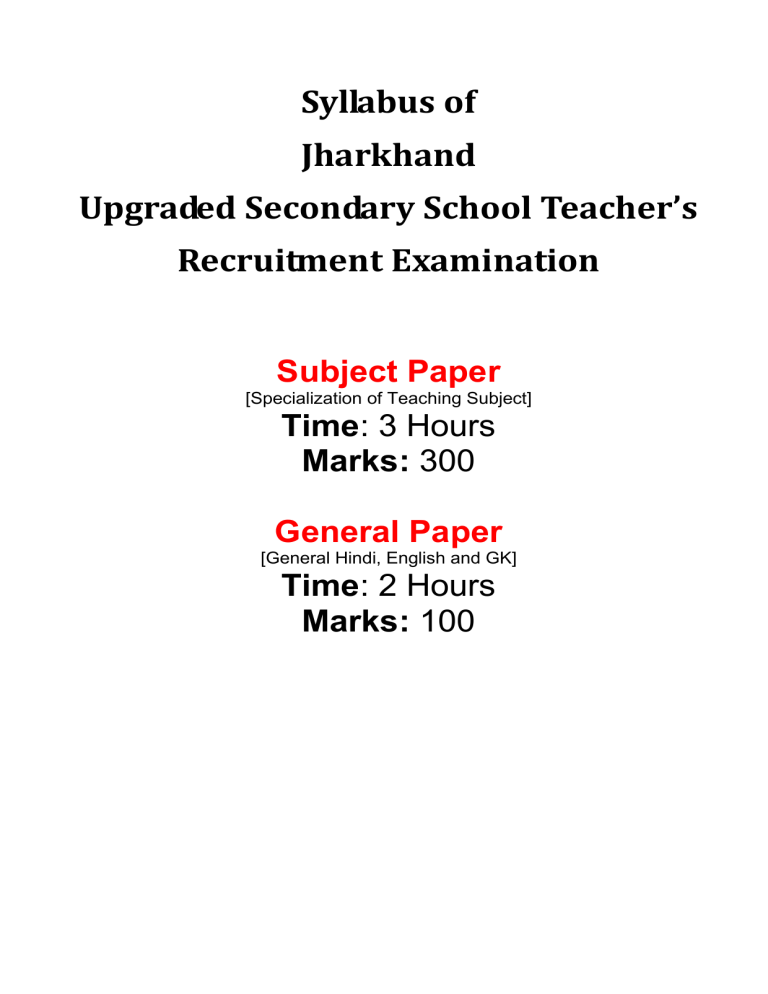
Syllabus of
Jharkhand
Upgraded Secondary School Teacher’s
Recruitment Examination
Subject Paper
[Specialization of Teaching Subject]
Time: 3 Hours
Marks: 300
General Paper
[General Hindi, English and GK]
Time: 2 Hours
Marks: 100
Syllabus: Upgraded Secondary School Teacher’s
Recruitment Examination fgUnh ¼
Hindi
½½½½
Ikw.kkZad & 300 Ikw.kkZad & 300
Lke; & izFke [k.
M
Hkkx & 1 fgUnh Hkk"kk dk fodkl vkSj fLFkfr
1- fgUnh Hkk"kk dk fodkl & izkjafHkd fgUnh] fganoh@fganqbZ] [kM+h cksyh dk lkfgR;d Hkk"kk ds :Ik esaa fodkl A
2- vk/kqfud ;qx esa fgUnh Hkk"kk dk fodkl & QksVZ fofy;e dkWyst] fgUnh i=dkfjrk] HkkjrsUnq ;qx] f}osnh ;qx A
3- Hkkjr la?k dh Hkk"kk ds :Ik esa fgUnh dk fodkl & lafo/kku esa fgUnh] jktHkk"kk] jk"VªHkk"kk vkSj lEidZ Hkk"kk] varjjk"Vªh; Hkk"kk ds :Ik esa fgUnh A
4- fgUnh Hkk"kk dk izkekf.kd vkSj rduhdh foLrkj & fgUnh Hkk"kk dk vk/kqfudhdj.k] izkS|ksfxdhdj.k vkSj ekudhdj.k] iz;kstuewyd fgUnh A
5- fgUnh dh lg;ksxh Hkk"kk,¡ vkSj budk ikjLifjd laca/k A
6- >kj[kaM dh Hkk"kkvksa vkSj cksfy;ksa dk lkekU; ifjp; A
Hkkx & 2 fgUnh lkfgR; dk bfrgkl
1- fgUnh lkfgR; ds vkfndky] HkfDrdky] jhfrdky vkSj vk/kqfud dky dh izeq[k lkfgfR;d izo`fŸk;k¡ vkSj jpuk,¡ A
2- vk/kqfud fgUnh dfork dh izeq[k izo`fŸk;k¡ & Nk;kokn] izxfrokn] iz;ksxokn] u;h dfork] vdfork vkfn vkSj izeq[k dfo A
3- vk/kqfud fgUnh dFkk lkfgR; dh izeq[k fo/kk,Wa & miU;kl] dgkuh dk fodkl vkSj izeq[k jpukdkj A
4- fgUnh esa jaxeap vkSj ukVd & ,dkadh dk laf{kIr bfrgkl A
5- fgUnh esa thouh] vkRedFkk] laLej.k] js[kkfp=] ;k=ko`r] fuca/k] fjiksrkZt vkfn dk fodkl vkSj fLFkfr A
6- fgUnh lekykspuk dk fodkl vkSj fgUnh ds izeq[k lekykspd A
7- >kj[kaM ds fgUnh lkfgR; dk lkekU; ifjp; A
Syllabus: Upgraded Secondary School Teacher’s
Recruitment Examination
English
Time – 3 Hours
Full Marks-300
Answer 12 (Twelve) questions selecting 6 (Six) from each part
Part I
1. Developments of Indian Writing in English (Poetry, Novel, Short Story, Non-fictional Prose,
Drama and Literary Criticism) from 1830 to Present Day. 50 Marks
2. Grammar: 40 Marks
Agreement of Subject and Verb, Noun and Verb, Forms of Verbs, Sequence of Tenses; Voice,
Narration, Transformation, Phrases, Clauses, The Use of Modifiers, Prepositions, Infinitives,
Gerunds, The Most Common Mistakes in English Usage, etc.
3. Letters and Applications of the following types: Official with various Government Departments,
Job Application, Business Correspondence between Organization and Consumers,
Memorandum, Memos, E-mail writing, Advertisements and Reports. 30 Marks
4. Comprehension of a Standard Prose Paasage. 30 Marks
1. Poetry
Part II
35+35= 70 Marks
(i) William Shakespeare: (a) From fairest, creature we desire increase.
(b) Look in the glass.
(c) As fast as thou shall wane, so faster thou growest.
(ii) John Donne:
(iv) William Wordsworth:
(iii) George Herbert:
(d) When I do count the clock that tells the time.
(a) A Hymn to God the Father
(b) Go and Catch a Falling Star
(a)
(b)
The Pulley
Virtue
(a) The Solitary Reaper
(b) Three Years She Grew
(v) John Keats:
(vi) T. S. Eliot:
2. Novel
(a)
(b)
(a)
(b)
Ode to Autumn
Ode to a Nightingale
Gerontion
Ash- Wednesday
40 Marks i. Earnest Hemingway : ii. Arundhati Roy :
3. Drama i. William Shakespeare ii. George Bernard Shaw
Books Recommended :
1. Indian Writing in English:
2. History of English Literature:
3. The Encyclopaedia of Business Letters,
Fax, Memos & E-mail:
4. A Practical English Grammar :
For Whom The Bell Tolls
The God of Small Things
Hamlet
Man and Superman
K.R. Srinivasa Iyengar
Legouis
40 Marks
Robert W. Bly (Master Mind Books Publication)
Martinet & Thompson
Syllabus: Upgraded Secondary School Teacher’s
Recruitment Examination laLd`re~ le; & 3 ?kaVk ijh{kk;ka 300 vadkReda i=e~ A losZ iz’uk% vfuok;kZ% Hkfo";fUrA
¼ijh{kk esa 300 vadksa dk i= gksxkA lHkh iz’u vfuok;Z gksaxsA½
laLd`rlkfgR;a laLd`rlkfgR;L;sfrgkl’p ¼laLd`r lkfgR; vkSj laLd`rlkfgR; dk bfrgkl½
¼v½ ikB~;xzUFkk%
¼d½ f’k’kqikyo/ke~ & izFkelxZL; izFken’k’yksdk% ¼izFke lxZ ds izFke n’k 'yksd½
¼[k½ fdjkrktqZuh;e~ & izFkelxZL; izFken’k’yksdk% ¼izFke lxZ ds izFke n’k 'yksd½
¼x½ vfHkKku’kkdqUrye~ & prqFkZ vad% ¼prqFkZ vad½ izR;sdxzUFkr% ,dSdk% 'yksdk% laLd`rs O;k[;kFkZe~] ,dSdk% 'yksdk% fgUnhHkk"kk;keuqoknkFkZa p iz"VO;e~ ¼izR;sd xzUFk ls ,d&,d 'yksd dh O;k[;k] vkSj ,d&,d 'yksd dk fgUnh Hkk"kk esa vuqokn iz"VO; gS ½
O;k[;k & 15 vad x 3 = 45 vad
vuqokn & 10 vad x 3 = 30 vad jkek;.ke~ ] egkHkkjre~ ] egkdkO;lkfgR;e~ ] ukV~;lkfgR;e~ vad foHkktue~ & x 2 =50 vad ¼’kCn lhek&500 'kCn½ fVIi.kh};e~ ¼nks fVIif.k;k¡½ & 125 vad x 2 =25 vad ¼’kCn lhek&200 'kCn½
¼d½ vifBrkuqPNsank/kkfjrk% izUpiz’uk% ¼vifBr vuqPNsn ij vk/kkfjr ik¡p iz’u & 4 vad x 5 = 20 vad ½
¼[k½ y?kqfl)kardkSeq|k% dkjdizdj.kkUrxZr lw==;L; lksnkgj.ka O;k[;k ¼y?kqfl)kardkSeqnh ds dkjd izdj.k ls rhu lw=ksa dh lksnkgj.k O;k[;k & 10 vad x 3 = 30 vad ½
¼x½ dkjdfoHkfDrn`"V;k prq.kkZa inkuka okD;s iz;ksxk% ¼dkjdfoHkfDr dh n`f"V ls pkj inksa dk okD; iz;ksx½
3 vad x 4 = 12 vad
¼?k½ iUpokD;s"kq v’kqf)la’kks/kue~ ¼ik¡p okD;ksa esa v’kqf)la’kks/ku & 3 vad x 4 = 12 vad½
¼Mñ½ lw=funsZ’kiwoZda lfU/kfoPNsnkFkZa iUpla;qDrinkfu ¼lw=funsZ’kiwoZd laf/kfoPNsn ds fy, ik¡p la;qDr in½
2 vad x 5 = 10 vad
¼p½ rqequ~ & DRok & Y;i~ & Dr& Drorq & 'kr` & 'kkup~ & izR;;k/kkfjrs"kq iUpksnkgj.ks"kq izR;;p;ue~
¼rqequ~] DRok] Y;i~] Dr] Drorq] 'kr`] 'kkup~ & bu izR;; ij vk/kkfjr ik¡p mnkgj.kksa esa izR;; p;u½
2 vad x 5 = 10 vad
¼N½ 'kCn:ik.;k/k`R; iUpiz’uk% ¼’kCn:Ik ij vk/kkfjr ik¡p iz’u½ & ckyd] dfo] jktu~] lk/kq] unh] yrk] efr]
Qy & 2 vad x 5 = 10 vad
¼t½ /kkrwuka :ik.;k/k`R; iUpiz’uk% ¼’kCn:Ik ij vk/kkfjr ik¡p iz’u½ & Hkw] iB~] gl~] ue~] vl~] lso~] uh] â]
Hkt~] bu /kkrqvksa dk yV~] yksV] y`V] yMñ ,oa fof/kfyMñ ydkjksa esa :i & 2 vad x 5 = 10 vad
¼>½ laLd`rHkk"kk;ka i=ys[kue~ ¼laLd`rHkk"kk esa i= ys[ku½ ¼’kCn lhek & 200 'kCn½ 12 vad x 1 = 12 vad
¼´½ laLd`rHkk"kk;ka ,d% fucU/k% ¼laLd`rHkk"kk esa fucU/k ys[ku½¼’kCn lhek & 500 'kCn½ 24 vad x 1 = 24 vad
Syllabus: Upgraded Secondary School Teacher’s
Recruitment Examination
Time – 3 Hours
Full Marks – 300 foKku & xf.kr
(Science – Mathematics)
Part- 1 (Physics)
12 (Twelve) questions to be answered selecting 6 (Six) question from each part.
1. (a) GENERAL PHYSICS: Vectors and properties of vectors, Relative velocity, Projectile, Uniform circular motion, Work energy and power, Gravitation and escape velocity, Kepler’s laws of planetary motion, elementary idea of Surface tension, Angle of contact, viscosity elementary ideas.
(b) RELATIVITY : Special theory of relativity and Lorentz transformation, Length contraction and time dilation, Velocity dependence of mass, Mass energy equivalence.
2. Heat and thermodynamics : Kinetic theory of gases, Zeorth law of Thermodynamics, First law of thermodynamics, Isothermic and Adiabatic processes, Reversible and Irreversible processes,
Second law of Thermodynamics, Carnot engine and its efficiency.
3. Optics : Simple and compound microscopes, Huygen’s principle, Interference of light,
(elementary ideas)
4. Electrostatics and Magnetism: Gauss’s theorem and its applications, electric potential and field at a point due to an electric dipole, Capacitors and combination of capacitors (Series and parallel),
Magnetic hysteresis, Classification of magnetic materials.
5. Current Electricity : Kirchhoff’s law and its application to a Wheatstone bridge, Heating effect of current, Biot-Savart’s law, Faraday’s law of electro-magnetic induction, Lenz’s law.
6. Atomic and Nuclear Physics : Structure of an atom, Bohr’s theory of hydrogen atom, Heisenberg’s uncertainty principle, Schrödinger’s equation.
7. Electronics : Intrinsic and extrinsic semiconductors, p-n junction diode, Zener diode, Half wave and full wave rectifiers, Transistors (P-N-P andN-P-N) and its characteristics in common- base and common emitter configurations, Decimal and binary systems and their inter – conversion, Basic logic and truth table, Boolean algebra.
Part – II (Mathematics)
1. Algebra
Set theory – Generalised De Morgan’s Law, countable and uncountable sets, Set mappings.
Theory of Equations : Relation between roots and coefficients, Transformation of Equation,
Symmetric function of roots.
2. Differential Calculus :
Functions, Continuity and Differentiability, Successive Differentiation , Leibnitz Theorem, Partial
3.
Differentiation, Euler’s Theorem Tangeut and Normal.
Integral Calculus
Indefinite Integration of Trigonometric, Rational and irrational functions. Properties of Definite Integral,
Reduction formula, Differential Education of first order, and 1 st
degree.
4. Co-ordinate Geometry
Standard Equation of Parabola, Ellipse. Hyperbola. Tangents and normal. [Diameter Excluded]
5. Co-ordinate Geometry three Dimension
Different coordinate systems and relation between them. Direction Cosines. Plane, Straight Line,
6. Trigonometry
DE Mocvre’s Theorem and its application. Complex Argument, Gregory Series, Summation of
Series.
Syllabus: Upgraded Secondary School Teacher’s
Recruitment Examination
BIOLOGY/ BIO SCIENCE
(Botany+Zoology+Chemistry)
Time – 3 Hours
GROUP – A MARKS- 300
6 (Six) questions to be answered selecting not less than three questions from part I and II,
Part –I (BOTANY)
Binomial Nomenclature of Plants with examples.
Cell structure of plants and function of cell organalles.
Structure and function of DNA.
Plant tissues, its structure and function.
Mitosis.
Parasitic and saprophytic mode of nutrition in plants.
Transpiration.
Photosynthesis and factors effecting photosynthesis.
Role of phytohormones in plants.
Reproduction in plants
Typical ecosystem, physical and biotic factors, food chain and energy flow.
Environmental pollution: Air, water and sound pollution and their control.
Part –II (Zoology)
1. Classification of animals up to class level with characters and examples.
2. Structure and function of Bio-molecules like Nucleic acid, protein, lipid, carbohydrates.
3. Mechanism of animal Cell Division, Replication, Transcription and Translation in
Prokaryotes and eukaryotes.
4. Mendel’s Law of heredity, Sex determination in Drosophila and man, Linkage and crossing over, Human Genetic Diseases, Mutation and their role in evolution.
5. Physiology of Digestion, Circulation, and Excretion in mammals. Mechanism of Nerve
Impulse conduction and Reflex action.
6. Endocrine glands and their Hormones with special reference to reproduction.
7. Theories of Evolution Darwinism, Lamarckism and modern synthetic theory.
8. Human Diseases, causative agents, symptom, prevention and their control. (Caused by
Bacteria and Viruses)
9. Deficiency diseases of Vitamins and Minerals.
10. Aquaculture, Apiculture, Sericulture and poultry farming and its economic importance.
GROUP – B (CHEMISTRY)
6 (Six) questions to be answered selecting not less 2 (Two) questions from part I, II & III.
PART – I (INORGANIC)
1. Atomic structure – Fundamental particles of matter, atomic model – Rutherford’s Hund’s rule,
Pauli’s exclusion principle.
2. Periodic table, periodicity of properties, electro negativity, electron affinity and ionization potential.
3. Chemical bonding : Co-valent bond, lonic bond, Hydrogen bonding, Vander Waal’s forces.
4. Co-ordination chemistry : Double and complex salt, werner’s theory, Effective atomic number, Valence bond theory in complexes.
5. General chemistry of Gr IB, IIA and IIB elements of periodic table. Extraction & Properties of
Silver, Boron, Phosphorous & and Chromium. Preparation, properties, structure and uses of their compounds.
6. Preparation, properties, structure and uses of following compounds – Hydrogen peroxide,
Ozone, Hydrazine, Hydroxylamine, Hydrazoic acid, Potassium permanganate.
7. (a) Different theories of acids and bases, Hard and soft acids. Reactions in Liquid NH
3.
(b) Principle involved in the separation of Cations, Solubility product, common ion effect.
8. Preparation, Properties, bonding and application of alkyls and acyls of Li and Sn.
PART – II (ORGANIC)
1. Hybridization in organic compounds, nomenclature of organic compounds.
2. Alcohols : Classification, Preparation, properties and distinction between different types of monohydric alcohols, phenols – preparation and properties, comparative acidic strengths of alcohols and phenols.
3. Carbohydrates : Classification and nomenclature, Glucose, Fructose, chain lengthening and chain shortening of aldoses, Conversion of glucose into fructose and vice-versa.
Determination of open chain and ring structure of glucose.
4. (a) Preparation and synthetic use of malonic ester & Griqnard reagent
(b) Preparation, properties and use of urea and Pyridine.
5. Explain Tetra valency of Carbon, Type of hybridization in organic Compounds (sp, sp
2
& sp
3
) hemolytic and hetreolytic bond breaking Explain Free Radical, Carbonium Ion & Carbanion, and their formation and stability. Effects in organic compounds :- Inductive, Mesomeric,
Hyper conjugation and resonance.
6. General Methods, Preparation, Preparation, Properties of Mono Carboxylic acid and their derivatives.
7. Types of isomerism – optical, geometrical and conformational, tautomerism.
8. (a) Synthetic polymers – Addition polymerization, free radical vinyl polymerization, condensation polymerization, polyesters and polyamides.
(b) Soaps and synthetic detergents, colour & constitution of deys and their synthesis, Oils and fats.
PART – III (PHYSICAL CHEMISTRY)
1. Thermodynamics : System and surrounding, types of systems, heat, work, Internal energy,
Heat capacities and relation between them, Calculation of Q, W, E and H in isothermal and adiabatic expansions of gases, Efficiency and thermodynamic scale of temperature, Hess’s law and kirchoff’s.
2. Characteristics of catalyst, preparation, purification, stability and properties of colloids.
3. Crystal lattice, Unit cell, Bravis lattice, Bragg’s equation.
4. (a) Gaseous states – Kinetic theory of gases, Ideal and Real gases, Van der waal’s equation, Critical Constants.
5. Rates of reaction, mathematical characteristics of simple chemical reaction – I Order, II
Order and pseudo- order, Determination of order of reaction, Arrhericus equation and its application.
6. Electro Chemistry – Specific, equivalent and molecular conductivities. Determination of specific and equivalent conductivities, effect of dilution on sp, equiv and molecular conductivities, Kohlrausch law, EMF of a cell and its determination.
7. Dipole moment and its determination, Refractive index and molecular refractivity, magnetic properties – Para magnetism and Ferro-magnetism.
Syllabus: Upgraded Secondary School Teacher’s
Recruitment Examination
History
¼bfrgkl½ iw.kkZad le; izR;sd [k.M ls N% N% iz’uksa ds mŸkj nsus gSa A izFke [k.M
1- izkphu Hkkjrh; bfrgkl ds L=ksr
2- ex/k lkezkT; dh LFkkiuk & ekS;Z oa’k & pUnzxqIr ekS;Z rFkk v’kksd
3- fodzekfnR; dh miyfC/k;k¡
4- g"kZo)Zu
5- vjcksa dk flU/k vkdze.k & dkj.k rFkk ifj.kke
6- fot;uxj dh LFkkiuk
7- ckcj dh miyfC/k;k¡
8- 'ksj’kkg dk 'kklu & izcU/k
9- vdcj & jktiwr uhfr rFkk /kkfeZd uhfr
10- eqxy lkezkT; ds iru dk & dkj.k
11- f’kokth dk 'kklu izcU/k
12- vkSjaxtsc
1- iyklh ,oe cDlj ds ;q) & dkj.k] ifj.kke ,oa egRo
2- ykMZ MygkSth
3- 1857 dh dzkafr & dkj.k rFkk egRo
4- jktk jkeeksgu jk;
5- Hkkjr NksM+ks vkUnksyu
6- dSfcusV fe’ku ;kstuk
7- vkS|ksfxd dzkafr
8- Qzkal dh jkT; & dzkafr&dkj.k rFkk ifj.kke
9- usiksfy;u cksukikVZ & mRFkku ,oa iru
10- izFke fo’o;q) & dkj.k rFkk ifj.kke
11- 1917 dh :lh dzkafr & dkj.k rFkk ifj.kke
12- f}rh; fo’o;q) & dkj.k rFkk ifj.kke
Syllabus: Upgraded Secondary School Teacher’s
Recruitment Examination
CIVICS
Time - 3 Hours
Full Marks – 300
12 (Twelve) questions to be answered selecting 6 (Six) questions each from part I & II
PART - I
Political Theory
1. Comparison between Traditional and Modern Political Science.
2. Behaviouralism : Meaning and characteristics.
3. (a) Liberty : Political liberty, Economics liberty
(b) Equality : Social Equality, Economic Equality and Relations between Liberty and Equality.
4. Democracy : Meaning and conditions for its success.
5. Political Party : Meaning and Functions.
6. Public Opinion : Meaning and conditions for the Formation of Public Opinions.
7. Citizenship : Methods of acquiring citizenship.
8. Welfare State : Meaning and Functions.
9. Gandhism : Styagraha.
10. Marxism : Theory of class struggle.
PART - II
Indian Political System
1. Preamble of the constitution : Salient features.
2. Fundamental Right and Directive Principles of State policy.
3. President : Election Process and Emergency Powers.
4. Loksabha and Rajya Sabha : Composition and Relation between the two.
5. Governor and Chief Minister : Appointment, Power and Functions.
6. Legislative Assembly : Composition & Functions.
7. Supreme Court and High Court : Jurisdiction Election Commission.
8. Public Service Commission : Composition & Functions.
9. Regionalism, Communalism & Naxalism.
10. Panchayati Raj: Importance of 73 rd
Constitutional Amendment Act.
Syllabus: Upgraded Secondary School Teacher’s
Recruitment Examination
Geography iw.kkZad le;
& 300 vad
(Part – I) izFke [k.M
1. Nebular hypothesis of the origin of the earth ( i`Foh dh mRifŸk dh fugkfjdk ifjdYiuk½
1. Structure of earth ( i`Foh dh lajpuk½
2. Difference between Rocks and Minerals ( pV~Vkuksa ,oa [kfutksa esa vUrj½
4. Mountains ( ioZr½
5. Earthquake ( HkwdEi½
6. Airy’s view on Isostasy ( larqyu ls lEcfU/kr ,;jh dk fopkj½
7. Weathering ( vi{k;½
8. Karst topography ( dkLVZ LFkykd`fr½
9. Structure of Atmosphere ( ok;qeaMy dh lajpuk½
10. Plantation Agriculture ( ckxkrh d`f"k½
11. Iron and Steel Industry of India (
Hkkjr dk ykSg ,oa bLikr m|ksx½
Cotton textile industry of Japan ( tkiku ds lwrh oL= m|ksx½
Part – II f} rh; [k.M
1. Physiography of India (
Hkkjr dh Hkw & vkd`fr½
2
. Climatic regions of India
3. Natural vegetation of India
(
Hkkjr dh tyok;q izns’k½
(
Hkkjr dh izkd`frd ouLifr½
4.
5.
6.
7.
8.
Water power of India (
Hkkjr dh ty 'kfDr ½
Cotton textile industry of India (
Hkkjr dh lwrh oL= m|ksx½
Distribution of Population in India (
Hkkjr esa tula[;k forj.k½
Agriculture regions of India (
Hkkjr ds d`f"k izns’k½
Physiography of Jharkhand (
>kj[k.M dh Hkw & vkd`fr½
9. Forest resources of Jharkhand ( >kj[k.M ds ou lalk/ku½
10. Fisheries of Japan ( tkiku dk eRL; O;olk;½
11. Distribution and production of Iron-ore of the world
( ykSg v;Ld dk fo’o forj.k ,oa mRiknu½
12. Energy resources of the world: Coal and Hydelpower
( fo’o ds ÅtkZ lalk/ku % & dks;yk vkSj tyfo|qr½
Syllabus: Upgraded Secondary School Teacher’s
Recruitment Examination
Time – 3 Hours
Full Marks – 300
ECONOMICS
Twelve (12) Questions to be answered selecting Six (06) Questions from each part.
PART – I
1. Concepts of Micro and Macro economics.
2. Demand and elasticity of demand.
3. Cardinal and ordinal approach to consumers equilibrium, consumer surplus.
4. Law of returns, price determination under perfect competition and monopoly.
5. Theories of the determination of rent, wages, interest and profit.
6. Concept and functions of money, quantity theory of money, inflation and deflation.
7. Functions of Central bank and Commercial banks.
8. Principal of maximum social advantage, causes of the growth of public expenditure,
Ability to pay theory of taxation, taxable capacity, Public debt and its redemption,
Budget.
9. Theories of taxation, Gains from International trade.
PART – II
1. Causes of the backwardness of Indian Economy, Forest and forest policy of India,
Energy problem in India.
2. Types of unemployment, causes and its remedies, Poverty, causes & its remedies,
Poverty, causes & its remedies, I.R.D.P., N.R.E.P., R.L.E.G.P., Antyoday, NREGA,
Food for work, SGRY
3. Indian population and Family welfare programmes.
4. Problems of Indian Agriculture, Cooperative farming, Problems of irrigation and
Irrigation policy of the Govt. of India.
5. Agriculture credit and role of Commercial Banks, Cooperative Banks and NABARD in solving the problems of agricultural credit.
6. Rail Road coordination in India.
7. Prospect and Problems of Iron and Steel, Cotton, Cement and Jute Industries in
India, Cottage Industry
8. Role of Public Sector Industries in the economic development of India.
9. Difference between growth and development, Human resources and economic development, Role of state in the economic development of India.
10. Consequences of price rise, F.D.I. and its effect on Indian economy.
Syllabus: Upgraded Secondary School Teacher’s
Recruitment Examination
URDU
Time - 3 Hours
Full Marks- 300
.
Every part consists of three groups. Candidates are required to answer 12 (Twelve) questions selecting at least four from each group.
Part – I
Urdu Poetry & Linguistics
(Group A)
3. Ghazlal
Text:
(i) (a) Nahaq ham majburon per …..
(b) faqeerana aaye sada kar chale….
(c ) Dekh to dil ke jaan se uthata hai ……. Meer Taqi Meer:
(ii) (a) Yeh na thi hamai qismat …..
(b) Nukta cheen hai gham-e-dil……
(c) Ibn-e- Mariam huwa kare …… Mirza Asadullah Khan Ghalib
Topics: Ghazal ka fan, Meer aur Ghalib ki shaeri ki khsusiat, Urdu shaeri men un ka moqam, unki azmat ki bunyaden, Shamil-e-Nasab ashar ki tashreeh
(Group B)
2. Nazm
Text:
I. (i) Barsat ki baharen (ii) kljug
(iii) Banjara nama Wali Mohammad Nazeer, Akber abadi
II. (i) Masjid-e-Qartuba (ii) Lenin Khuda ke huzoor mein
(iii) Aek aarzoo or Mohammad Iqbal.
Topics: Nazm ka fan, Nazir aur Iqbal ki shaeri di khususiyat, Urdu shaeri men un ka moqam, Nazir ki awami aur Hindustani shaeri, Iqbal ki watni aur milli shaeri, Shamil-e-Nasab un ki Nazon ki tashreeh.
(Group C)
3. Lissaniat
Topics:
Maghrabi Hindi, Khari boli se Urdu ka rishta, Urdu rasmul khat
Part – II
Urdu Fiction & Grammar
(Group A)
1. Noval
(i) Umra-o-Jaan-e- ada – Mirza Hadi Ruswa
(ii) Fire Area – Ilyas Ahmad Gaddi
Topics: Novel ka Fan, Shamil-e-Nasab Novelon ka Taruf, In ke mauzuaat, In ke markazi kirdar, Urdu keaham Novelon ke darmeyan in ka Moqam.
(Group B)
2. Afsana
(i) Namak ka Darogha, Poos ki raat, Kafan – Prem Chand
(ii) Maha Lakshmi ka Pul (Krishan Chander), Apne Dukh Mukhe De Do (Rajendar
Singh Bedi), Toba Tek Singh( Sadat Hasan Manto)
Topics: Afsane ka Fan, Shamil-e-Nesab Afsanon ka Taruf, In ke Mauzuaat, In ke markazi kirdar, Inke aham kirdar, Urdu kea ham Afsanon ke darmeyan in ka Moqam.
(Group C)
3. Grammar
(i) Ism, Zameer, Sifat-Tareef aur Misalen
(ii) Motazad, Muhawerat, Zaban-o-Bayan ki Ghaliyan aur unki islah
Syllabus: Upgraded Secondary School Teacher’s
Recruitment Examination
Ikw.kkZad %& 100
Lke; %& 2 ?kaVk
Ikz’u Ik= & I ¼lkekU; fgUnh] lkekU; vaxzsth ,oa lkekU; Kku½
[k.M & 1
LkkekU; fgUnh
,d&,d vad ds iphl oLrqfu"B iz’u iwNs ,d&,d vad ds iphl oLrqfu"B iz’u iwNs tk;saxs A
¼v½ O;kdj.k ls ,d&,d vad ds nl oLrqfu"B iz’u gksaxs %&
1- Hkk"kk
2- laKk] loZuke] fdz;k] fo’ks"k.k
3- dky
4- fyax
5- opu
6- dkjd
7- lfU/k
8- lekl
9- milxZ] izR;;
10- eqgkojs] yksdksfDr
11- 'kCn Kku %& vk/kqfud fgUnh lkfgR; esa fu/kkZfjr dgkuh ,oa dfork i<+uk visf{kr gS A dgkuh ls ,d&,d vad ds lkr oLrqfu"B iz’u gksaxs %&
1- izsepUn
2- jkeo`{k csuhiqjh
&
& iap ijes’oj lqHkku [kkW
3-
4- t;’kadj izlkn js.kq
5- deys’oj
6-
7- m"kk fi;oank fueZy oekZ
8- eUuw HkaMkjh
9- Hkh"e lkguh
10- eksgu jkds'k
& e/kqvk
& yky iku dh csxe
&
& okilh
& ifjUns
&
&
& fnYyh esa ,d ekSr nks dykdkj phQ dh nkor eycs dk ekfyd
¼l½ dfork ls ,d&,d vad ds vkB oLrqfu"B iz’u gksaxs
1- fujkyk
%&
& tkxks fQj ,dckj
2- izlkn
3- iar
4- egknsoh oekZ
5- jke/kkjh flag fnudj
&
&
&
& fgekfnz rqax J`ax ls
Hkkjr ekrk e/kqj&e/kqj esjs nhid ty tura= dk tUe
6- dsnkj ukFk flag
7- 'ke’ksj cgknqj flag
8- Hkokuh izlkn flag
9- ukxktqZu
10- /kwfey
&
&
&
&
& jksVh m"kk xhr&Qjks’k
Lons’kh 'kkld vkt eSa yM+ jgk gaw A
GENERAL ENGLISH
Syllabus
Twenty five Objective Type Questions shall be asked
A. Grammar 10 questions of one mark each
1. Types of Noun, Pronoun, Verb and Adjective
2. Tense
3. Modals
4. Voice
5. Narration
6. Transformation
7. Clauses
8. Phrases
9. Determiners
10. Prepositions
B. Poetry
1. John Milton
2. William Wordsworth
3. Lord Tennyson
4. H.L.V. Derozio
5. William Shakespeare
C. Story
1. R.K. Narayan
2. K. Mansfield
3. Oscar Wilde
4. O. Henry
5. R.N. Tagore
D. Identification of
correct Sentences
:
:
:
:
:
:
:
:
:
:
:
05 questions of one mark each
On His Blindness
The Education of Nature
Break, Break, Break
My Native Land
Look in the glass.
05 questions of one mark each
The Tiger’s Claws
Sun and Moon
The Selfish Giant
The Dream
Kabuliwallah
05 Questions of one mark each.
GENERAL KNOWLEDGE
There shall be fifty questions of multiple choice answer type carrying one marks each.
JHARKHAND :
15 Marks
(A) Civilization and culture with special emphasis tribes of Jharkhand: Folk dances songs, fairs and Festivals, Rituals and traditions, Marriage systems, Taboo and Totem, Sadans,
Witchcraft.
(B) Geography : Nomenclature, Location and boundary, Land and People, Hills, Falls, Lakes and reservoirs, Monuments, Archaeology, Important places, Districts and Commissionaires,
Forests and Wild life sanctuaries.
(C) Economy : Mineral and Forest wealth, Power production, Industries based on Coal, Iron,
Copper and Aluminium, Education System, Important Crops, Population and Development plans.
(D) History : Jharkhand Movement , Kol revolt, Santhal Hul, Birsa movement and Tana
Bhagat movement.
(E) Important personalities and Freedom fighters.
INDIA :
10 Marks
(A) Dances and Music, Fairs and Festivals, Important tournament and prizes related with games and sports.
(B) Indian National Movement : Freedom fighters, Important events.
(C) XI five year Plan
(D) Important Places and Mounments.
(E) State and capitals, Defence and Security, Galantary awards
.
WORLD :
10 Marks
(A) U.N.O. World wars, Pacts and agreements.
(B) Important Deserts, Mountains, Continents, Oceans, Rivers, Biggest, Largest, Longest &
Highest features.
(C) Nations/ Countries, their capitals, Currencies and Languages.
GENERAL SCIENCE :
05 Marks
Questions on General Science covering general appreciation and understanding of science including matters of day to day observation and experience.
05 Marks
CURRENT AFFAIRS :
(A) India
(B) World 05 Marks
GJ Tutorial http://www.gjtutorial.com
Study Material for
English and GK
Covers all Topics
Contains Hundreds of Objective Questions
Call 98551-71046
NOTE:
The syllabus has been adapted from http://www.jharkhandjpsc.org/MiddleSchoolSyl.doc
Please confirm the latest syllabus from the official website.
